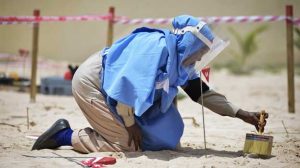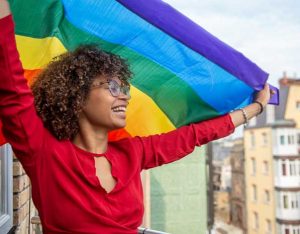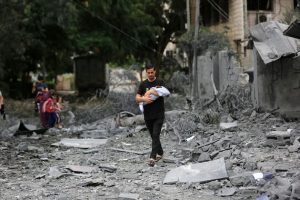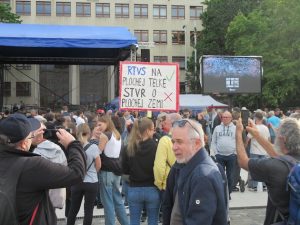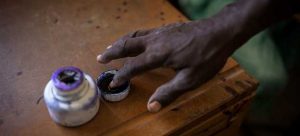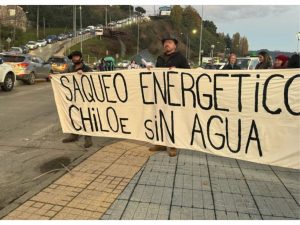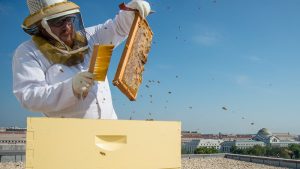The Human Consciousness Now...Our World in the Midst of Becoming...to What? Observe, contemplate Now.
UNITED NATIONS, May 6 2024 (IPS) - The United Nations Office of Rule of Law and Security Institutions (OROLSI) supports the promotion of the rule of law, security, and peace in conflict-affected countries.
In an interview with Kingsley Ighobor of Africa Renewal, Alexandre Zouev discusses OROLSI’s initiatives in Africa, rule of law on the continent, recent coups and their ramifications, and youth’s role in fostering peace and development.
The following are excerpts:
What’s the Office of the Rule of Law and Security Institutions about?
We deal mostly in five major areas, which are: the Police Division, Justice and Corrections Service, Disarmament, Demobilization and Reintegration Section, Security Sector Reforms, and Mine Action Service.

Alexandre Zouev
How would you assess the current state of the rule of law in Africa?
As you know, lately, we’ve witnessed some global geopolitical tensions that don’t help the rule of law. Over the last one to two years, the rule of law eroded globally, in many, if not the majority of countries. Latest data indicate that up to 6 billion people globally live in a country where the rule of law is weakened. We are concerned about this trend.
Talking about Africa, especially sub-Saharan Africa, the rule of law deteriorated in more than 20 countries. However, I must note that about 14 African countries managed to strengthen their rule of law over the last 12 months, including Kenya, Liberia, Tanzania and Cote d’Ivoire.
Do you ascribe the deterioration of the rule of law in African countries to geopolitical challenges?
Of course, global challenges to peace and security have implications for the rule of law. In terms of organizing elections or managing the judiciary or penitentiary, many African countries still depend on external technical assistance.
In many of these situations, there are also internal drivers such as a lack of access to justice, the absence of adequately trained law enforcement and an independent judiciary. So, it’s a combination of regional and global instability and internal factors.
There appears to be a resurgence of military coups, especially in West Africa.
You are right. We have witnessed the military taking power, especially in the greater Sahel Region. It doesn’t help the rule of law if, instead of a civilian justice system, you have military forces playing a role in political and judicial systems.
How are you helping these countries address these challenges?
As I said earlier, Africa is our major focus, especially sub-Saharan Africa. And it’s due to different reasons: some gaps in the rule of law in some countries and because of certain development challenges. Generally, poverty is very much linked to criminality and ill-functioning judiciary systems. Budget deficits and lack of effective fiscal management will prevent any state from allocating adequate resources to the rule of law sector. In an ideal situation, the rule of law should be very well-resourced but not every state can afford it.
Do you also work with, for example, civil society organizations in countries?
We invest efforts in working with civil society organizations. In our view, women and youths are very important agents of peace. We have many strategic frameworks with the African Union (AU). The AU and the EU are two major regional organizations partnering with UN Peacekeeping, including my office.
At the sub-regional level, we have different degrees of engagement. For example, we partner with the Inter-Governmental Authority on Development (IGAD), United Nations Office for West Africa and the Sahel(UNOWAS), Economic Community for West African States (ECOWAS), Southern Africa Development Commission (SADC), and other subregional organizations.

Téné Maïmouna Zoungrana, winner of the 2022 Trailblazer Award for Women Justice and Corrections Officers, trains prison officers on managing incidents in prisons. They rehearse intervention techniques to control inmates in case of an incident. Credit: MINUSCA/Herve Cyriaque Serefio
How important are security sector reforms (SSR) to the rule of law?
It’s a small but very important part of my office because SSR deals with sometimes sensitive military and security issues with important political implications. And not all governments want to be scrutinized.
To support SSR requires reliable statistics. For example, how much is being spent on the military, civil defense, secret services? When states request, we can help bring to them best practices and ways in which to build the capacity of their security sector. You do this kind of work with full respect to independent decision-making by host countries, their sovereignty, confidentiality of processes, and non-disclosure of information to third parties.
Do you support countries where there are no peace operations?
Absolutely. OROLSI has a system-wide service provider mandate. We are increasingly focusing on prevention, which is much more cost effective. One of the main tools we developed for that is the institutional development advisory programme. We piloted this programme in the Sahel region. We deploy institutional development advisors to help national governments and the UN system address the main challenges facing the rule of law and security institutions.
So, the IDAs are not transactional or mission-driven like assistance. We rely on the resident capacity within the UN system. We work with other UN partners, especially United Nations Development Programme (UNDP), United Nations Office for Disarmament Affairs (UNODA), and the Office of the United Nations High Commissioner for Human Rights (OHCHR)— OHCHR because, in many cases, the rule of law requires the promotion of a culture of human rights. So, IDAs help integrate inter-agency collaboration. It has so far proven very successful.
Many countries confront violent extremist groups such as Boko Haram. What role do you play in helping tackle this problem?
Peacekeeping was not established in the UN system for counter-terrorism operations. Therefore, we collaborate closely with the Office of Counterterrorism (OCT), and the Counterterrorism Committee Executive Directorate (CTED), which was established by the Security Council.
Almost all UN agencies and departments are involved in the prevention of violent extremism. And we are no exception. Our comparative advantage lies in building the capacity of host states to counter terrorism and prevent violent extremism through strengthened rule of law and security institutions and programmes to assist affected populations including through community policing and DDR.
If you look at some terrorist organizations such as ISIS, it’s not only about men and women fighting with arms; they have their families, sometimes even children, who are indoctrinated. Some left their countries, and to reintegrate them is not easy.
Do you see positive outcomes from your work in Africa?
Generally, we are getting a lot of resources from the assessed budgets of the United Nations and extra-budgetary contributions of our donors, but it’s not sufficient.
Investment in any kind of reform or capacity building in the rule of law sector is a multi-year exercise; you cannot do it overnight, in one week, or one month. We are going in the right direction, but maybe not with the speed that I would like.

Bangui, Central African Republic, 20 July 2023: The Appeals Chamber of the Special Criminal Court (SCC) delivered its judgement in the so-called “Paoua” case, on 20 July 2023 in Bangui. Credit: MINUSCA / Francis Yabendji-Yoga
Do the closures of peacekeeping missions in Africa, such as in Mali, complicate your work?
What complicates our work is not the closure or liquidation of missions; it’s how it happened in a hostile environment and under unrealistically short timelines. evacuating, liquidating, phasing out and drawing down missions can be challenging. However, we successfully closed our missions in Liberia, Cote d’Ivoire, and Mozambique.
Countries like Mali and Sudan are, maybe, more challenging environments. To close our mission in Mali, which was one of the largest missions with about 13,000 personnel, thousands of vehicles, and armored carriers, the government gave the Security Council only six months. It was almost mission impossible, but we managed to do it.
What role do you think young Africans can play in fostering peace and development of the continent?
As you know, the Secretary-General has an Envoy on Youth. I believe in investment in our future, which young people represent. It doesn’t matter if it’s in Africa, Asia, or Europe, it’s important to involve young people—for the sake of not only my generation but also that of my children and grandchildren.
When young people are educated, they become important agents of change. I am not necessarily talking about political or legal education. Sometimes, it may be engagement in sports or cultural events.
Can you envision an Africa without war?
Dr. Martin Luther King said, “I have a dream.” I, too, have a dream that one day we will shut down this shop [his office]. If there are no wars and no conflicts, there will be no need for peacekeeping.
Looking into certain developments in sub-Saharan Africa, the Maghreb in the north of Africa, you saw what happened in Libya over the last few years; you see what’s going on in Sudan; in Somalia, we still have the confrontation between al Shabaab and the Somali government.
Realistically, we cannot stop these conflicts overnight. So long as they exist, we should invest more in certain types of peacekeeping operations, perhaps AU-led. I believe that African problems can be solved by Africans.
We need partnerships with regional organizations such as the EU and the AU, and other sub-regional organizations in Africa. The private sector should play a special role, including African business leaders. Some of them already invest in peacebuilding and sustainable economic systems.
We need to get the best out of all of us.
Source: Africa Renewal, United Nations
Africa Renewal is a United Nations digital magazine that covers Africa’s economic, social and political developments, and the challenges the continent faces and solutions to these by Africans themselves, including with the support of the United Nations and international community.
IPS UN Bureau

For the rural farmers in Chile, a combination of climate change-induced mega droughts, water policies that make access unaffordable and a State that either doesn’t want to or dares not intervene in the water market means family enterprises are dying out.
MONTEVIDEO, Uruguay, May 6 2024 (IPS) - On 22 April, Dominica’s High Court struck down two sections of the country’s Sexual Offences Act that criminalised consensual same-sex relations, finding them unconstitutional. This made Dominica the sixth country in the Commonwealth Caribbean – and the fourth in the Eastern Caribbean – to decriminalise same-sex relations through the courts, and the first in 2024.
Similar decisions were made in Antigua and Barbuda, St Kitts and Nevis and Barbados in 2022 – but progress then threatened to stall. Change in Dominica revives the hopes of LGBTQI+ activists in the five remaining English-speaking Caribbean states – Grenada, Guyana, Jamaica, St Lucia and St Vincent and the Grenadines – that still criminalise same-sex relations. Sooner than later, one of will be next. A small island has made a big difference.
Winds of change
The criminalisation of consensual gay sex in the Anglophone Caribbean dates back to the British colonial era. All former British colonies in the region inherited identical criminal laws against homosexuality targeting either LGBTQI+ people in general or gay men in particular. They typically retained them after independence and through subsequent criminal law reforms.
That’s what happened in Dominica, which became independent in 1978. Its 1998 Sexual Offences Act retained criminal provisions dating back to the 1860s. Section 16 of that law made sex between adult men, described as ‘buggery’, punishable with up to 10 years’ imprisonment and possible compulsory psychiatric confinement.
The offence listed in section 14, ‘gross indecency’, was initially punishable by up to five years in jail if committed by two same-sex adults. A 2016 amendment increased the penalty to 12 years.
As in other Caribbean countries with similar provisions, prosecutions for these crimes have been rare in recent decades, and have never resulted in a conviction. But they’ve been effective in stigmatising LGBTQI+ people, legitimising social prejudice and hate speech, enabling violence, including by police, obstructing access to essential social services, particularly healthcare, and denying people the full protection of the law.
Change has begun only in the past decade, but it’s been rapid. Bans on same-sex relations were overturned by the courts in Belize in 2016 and Trinidad and Tobago in 2018. More soon followed.
The legal case
In July 2019, an unnamed gay man identified as ‘BG’ filed a legal case challenging sections 14 and 16 of the Sexual Offences Act. The defendants named in the complaint were the Attorney General, the Bishop of Dominica’s capital Roseau, the Anglican Church and the Methodist Church. The Dominica Association of Evangelical Churches was also listed as an interested party.
The lawsuit was supported by Minority Rights Dominica (MiRiDom), the country’s main LGBTQI+ advocacy group, and three international allies: the Canadian HIV/AIDS Legal Network, the University of Toronto’s International Human Rights Program and Lawyers Without Borders. The law was challenged as discriminatory and an enabler of violence against LGBTQI+ people.
The High Court heard the case in September 2022, and on 22 April 2024, Justice Kimberly Cenac-Phulgence issued a ruling setting out the reasons why sections 14 and 16 violated the applicant’s constitutional rights to liberty, freedom of expression and privacy, and were therefore null and void.
The backlash
LGBTQI+ advocates around the world welcomed the court ruling, as did UNAIDS – the United Nations agency leading the global effort to end HIV/AIDS. But resistance wasn’t long in coming.
Religious institutions, which hold a lot of influence in Dominica, were quick to decry gains in LGBTQI+ rights as losses in moral values. The day after the ruling was announced, Dominica’s Catholic Church published a statement reaffirming its position that sex should only take place within a heterosexual marriage and, while expressing compassion towards LGBTQI+ people, reiterated its belief in the centrality of traditional marriage and family. The Seventh-day Adventists expressed alarm about the potential of the court ruling to lead to same-sex unions and marriages. Some faith leaders voiced outright bigoty, with one prominent figure calling sexual acts between persons of the same sex an ‘abomination’.
The road ahead
Having decriminalised same-sex relations, Dominica is now ranked 116th out of 198 countries on Equaldex’s Equality Index, which rates countries according to their LGBTQI+ friendliness. There’s clearly much work to be done. Outstanding issues include protection against discrimination in employment and housing, marriage equality and adoption rights. LGBTQI+ activists will also continue to push for the recognition of non-binary genders, the legalisation of gender change and the prohibition of conversion therapy.
The Equality Index makes clear that, as in all the Caribbean countries that have recently decriminalised same-sex relations, changes to laws remain far ahead of social attitudes, with considerable public homophobia. As the instant conservative reactions to the court ruling suggest, changing laws and policies isn’t nearly enough. Shifting social attitudes must now be a top priority.
Dominican LGBTQI+ activists know this, which is why they’ve been working to challenge prejudice and foster understanding since long before launching their legal challenge – and why they see the court victory as not the end of a journey but a stepping stone to further change.
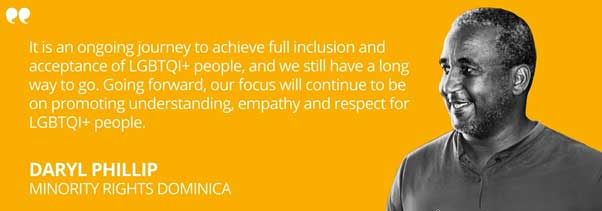
The challenge for Dominica’s LGBTQI+ civil society is to replace the vicious circle of legal prohibition, which has reinforced social stigma, with a virtuous one in which legal progress normalises the presence and social acceptance of LGBTQI+ people, which in turn enables effective access to legally enshrined rights.
But they’ll take heart from being part of a broader regional and global trend. While working to ensure rights are realised domestically, they’ll also offer a powerful example that change can result to the circa 64 countries around the world that still criminalise gay sex, including the five holdouts in the Commonwealth Caribbean. More progress will come.
Inés M. Pousadela CIVICUS Senior Research Specialist, co-director and writer for CIVICUS Lens and co-author of the State of Civil Society Report.
UNITED NATIONS, May 6 2024 (IPS) - Nearly seven months into the Gaza war, the UN warns that to rebuild and restore the buildings lost in this period, it would take several decades, and to revitalize Palestine’s economy, it would be a great undertaking. Meanwhile, the great losses in housing and public services and the economic stall only threaten to push even more Palestinians into poverty.
Last week, the UNDP and the Economic and Social Commission in Western Asia (ESCWA) released an update to their joint report, ‘The Gaza War: Expected Socio-Economic Impacts on the State of Palestine,’ first released in November 2023. The initial report projected that the war would see a projected loss of over 12 percent in Palestine’s GDP and an increase in the poverty rate of over 25 percent if it persisted for a three-month period as metrics for the losses that the state of Palestine would incur as a result of the war.
The latest report reveals the predicted losses that Palestine will suffer after nine months of the conflict. According to projections that estimate the war’s duration up to a nine-month period, the poverty rate could exceed 60 percent. As Director of the Regional Bureau for the Arab States for UNDP Abdallah Al Dadari explained to reporters, an additional 1.8 million people have fallen into poverty in Palestine since the beginning of the war.
Under the UNDP’s Human Development Index (HDI), it’s projected that at six months, Palestine will have seen a significant drop, reaching 0.677 compared to 0.716 in 2022, which sets back human development by 17 years. This will only decrease based on certain metrics, such as reduced life expectancy, a decline in the gross national income (GNI), and reduced years of schooling.
In Gaza alone, the setback in development exceeds more than 30 years under this scenario, as it suffered a drop of 0.598 percent in 2023, compared to 0.705 percent in 2022. Should the war persist for nine months, the HDI will likely see a decrease of 0.551 percent, which sets Gaza back to the 1980s.
Almost all economic activities in Gaza have taken a sharp decline since the start of the war, the report stated, with all major sectors reporting significant losses during the last quarter of 2023. This has had ripple effects across the entire occupied Palestinian territory. The unemployment rate in Palestine reached 57 percent in the first quarter of 2024, as over 507,000 jobs were lost across the territory, including 160,000 workers from the West Bank.
Palestine’s GDP has also declined by 22.5 percent for the year 2023 and could further decrease by 51 percent in 2024. The war has undoubtedly aggravated the socioeconomic costs that will impact post-war recovery and development across the state of Palestine.
“Every additional day of fighting is only adding to the cost of rebuilding,” Al Dadari told reporters during a virtual briefing. Since the war began in October 2023, the destruction and damage to physical infrastructure, amounting to USD 341.2 million in education (schools and universities), USD 503.7 million in WASH, and USD 553.7 million in health facilities, directly affect basic needs provision in Gaza. The report notes that foreign aid for reconstruction and recovery of basic service infrastructure will be essential for the re-establishment of these services, and it will take decades and considerable financial resources to restore socioeconomic conditions in Gaza to pre-war levels.
Over thirty of Gaza’s hospitals have been destroyed since the war began, and over 400 schools and universities have been totally or partially destroyed under military fire.
Al Dadari emphasized the importance of bringing immediate emergency relief into Gaza that would help bring in emergency shelters. He remarked that a 3-year programme would cost up to USD 3 billion, with the overall cost ranging anywhere from USD 40 to 50 billion to rebuild the lost infrastructure in the long term. To even make room for the temporary emergency shelters and facilities that will be needed, efforts will need to be made to clear out the reported 37 million tons of debris in Gaza.
In addition to addressing the immediate needs of civilians in Gaza, UNDP will also be focused on planning a reconstruction plan with the full support of the UN and its organizations. “Our main concern is to be ready on any possible day to bring in the shelters and any necessary services. That is what we are doing in resource mobilization,” said Al Dadari.
“Unlike previous wars, the destruction in Gaza today is unprecedented in scope and scale, and coupled with the loss of homes, livelihoods, natural resources, infrastructure, and institutional capacities, it may have deep and systemic impacts for decades to come,” said ESCWA Executive Secretary Rola Dashti.
“Unprecedented levels of human losses, capital destruction, and the steep rise in poverty in such a short period of time will precipitate a serious development crisis that jeopardizes the future of generations to come,” said UNDP Administrator Achim Steiner.
IPS UN Bureau Report
BRATISLAVA, May 3 2024 (IPS) - A new report has warned media freedom in the EU is close to “breaking point” in many states amid rising authoritarianism across the continent.
In its latest annual report covering 2023, the Berlin-based Civil Liberties Union for Europe (Liberties) highlighted widespread threats, intimidation and violence against journalists and attacks on the independence of public broadcasters in the EU, with roll backs in media freedom down to “deliberate harm or neglect by national governments”.
The group says its research confirms a continuation of alarming trends seen in the previous year, including heavy media ownership concentration, insufficient ownership transparency rules, and threats to the independence and finances of public service media,
And it warns the decline in media freedom seen in a number of EU member states has the potential to pose a direct threat to democracy.
“Media freedom is falling across Europe, and what we see, not just in Europe but in many places around the world, is that where media freedom declines, the rule of law declines too,” Eva Simon, Senior Advocacy Officer at Liberties, told IPS.
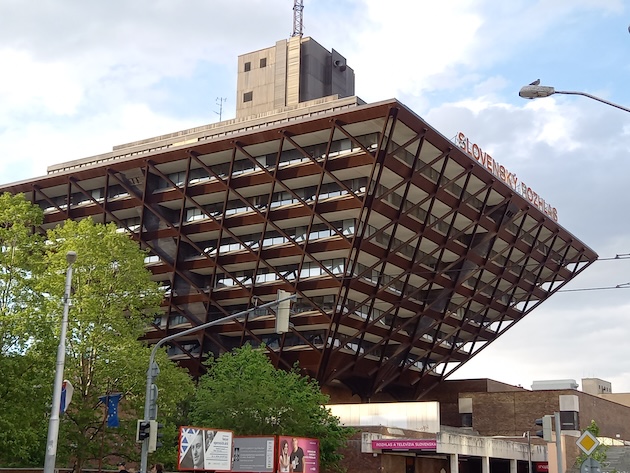
The Slovak Radio building in Bratislava, part of the RTVS public broadcaster. Credit: Ed Holt/IPS
The Liberties report, compiled with 37 rights groups in 19 countries, comes as other media freedom watchdogs and rights groups warn of growing concentration of media ownership, lack of ownership transparency, surveillance and violence against journalists in EU countries, government capture of public broadcasters, and rising restrictions on freedom of expression.
Press freedom watchdog Reporters Without Borders (RSF) released its annual World Press Freedom Index today (April 3, 2024), warning that politicians in some EU countries are trying to crack down on independent journalism. They single out a number of leaders as being “at the forefront of this dangerous trend,” including Hungary’s pro-Kremlin prime minister, Viktor Orban, and his counterpart in Slovakia, Robert Fico.
It also highlights concerns for press freedom in other places, such as Malta, Greece, and Italy, pointing out that in the latter—which fell in the Index’s rankings this year—a member of the ruling parliamentary coalition is trying to acquire the second biggest news agency (AGI), raising fears for future independence of media.
“One of the main themes of this year is that the institutions that should be protecting media freedom, for example, governments, have been undermining it,” Pavol Szalai, head of the EU/Balkans desk at RSF, told IPS.
Like Liberties, RSF has cited particular concern about media freedom in Hungary and Slovakia among EU states.
Media freedom has been on the decline in Hungary for more than a decade, as autocratic leader Orban has, critics say, steadily cracked down on independent journalism. His party, Fidesz, has de facto control of 80 percent of the country’s media, and while independent media outlets still exist, their sustainable funding is under threat as state advertising is funneled to pro-government outlets.
The government’s effective control of Hungary’s public broadcaster is another major concern.
“Capturing public broadcasters limits access to information and that can have a huge impact on formulating political opinions and then how people vote,” said Simon.
Hungary is also suspected of having arbitrarily monitored journalists using the controversial Pegasus software.
RSF and Liberties both say their worry is not just what is happening to media freedom in Hungary, but that what Orban has done has provided a blueprint for other autocratic leaders to follow.
“Leaders in Europe are being inspired by Orban in his war against independent media. Just look at Fico in Slovakia, who has declared war on independent media,” said Szalai.
For years, Fico has repeatedly attacked and denigrated independent media and journalists.
In 2018, investigative journalist Jan Kuciak—who had been looking into alleged corruption by people close to Fico’s government— and his fiancée Martina Kusnirova were murdered. Critics said Fico’s rhetoric against journalists had contributed to creating an atmosphere in society that allowed those behind the killings to believe they could act with impunity.
Independent journalists continue to face harassment and abuse from Smer MPs today.
Since being elected Prime Minister for the fourth time last autumn, Fico and the governing coalition led by his Smer party have continued their attacks. They also refuse to communicate with critical media, claiming they are biased.
It has also approved legislation—which is expected to be passed in parliament within weeks—that will see the country’s public broadcaster, RTVS, completely overhauled and, critics say, effectively under the control of the government.
“If the bill is passed and signed into law in its current form, RTVS will become a mouthpiece for government propaganda,” said Szalai.
The government has rejected criticism over the bill and argued changes to RTVS are necessary because it is no longer objective, is persistently critical of the government, and is not fulfilling its remit as a public broadcaster to provide balanced and objective information and a plurality of opinions. A senior official at the Slovak Culture Ministry who is among the favorites to take over as head of the public broadcaster in its new form has since suggested that people who support the flat-earth theory should be invited onto shows to air their opinions on the broadcaster.
The bill has led to public protests and threats of a mass strike from current RTVS employees.
However, against this grim backdrop, media watchdogs say new EU legislation provides hope for an improvement in media freedom.
The recently-passed European Media Freedom Act (EMFA), which takes full effect across the EU in August next year, will, among others, ban governments from pursuing journalists to reveal their sources by deploying spyware, force media to disclose full ownership information, introduce transparency measures for state advertising, and checks on media concentration. It also provides a mechanism to prevent very big online platforms from arbitrarily restricting press freedom.
Another key measure in the legislation is that it enshrines the editorial independence of public service media, setting out that leaders and board members of public media organizations be selected through “transparent and non-discriminatory procedures for sufficiently long terms of office.”
“It is a good law that creates a very important base [for ensuring media freedom], which can be built on in the future. More safeguards [to media freedom] could be added to it in the future,” said Simon.
Szalai agreed, highlighting that the legislation was legally binding for member states. He admitted it had some shortcomings—for example, under some exceptions, journalists could be forced to reveal sources—but emphasized that it would take precedence over any national legislation, “and so governments cannot ignore it or try to get around it.”
But its implementation will be down to individual governments and authorities—something, that media freedom organizations have said must be closely watched.
A new EU body, the European Board for Media Services, is to be set up to oversee the implementation of the laws.
“It is important to make sure that the forces attacking media freedom are held back by this law. It will be up to the European Commission to hold governments to account on its implementation, and the Commission needs to consider press freedom as a priority after the European Parliament elections [in June] and to check on the EMFA’s implementation and take measures against any countries that violate it,” said Szalai.
IPS UN Bureau Report
IPS UN Bureau, IPS UN Bureau Report,
BERLIN, Germany, May 3 2024 (IPS) - The year 2024 seems to be a year of big decisions. The European Parliament elections in June and the US presidential election in November… politics and the media are talking of a showdown between democracy and disinformation. Add the elections in Russia and India to that and almost half of the world’s population will be casting their vote this year.
According to EU High Representative Josep Borrell, ‘malicious foreign actors’ are trying to win the ‘battle of narrative’. Disinformation is being pumped out, aimed at dividing society and undermining trust in state institutions, as stated by the German Federal Government.
Social media is purportedly being used to spread lies, disinformation and deep fakes, which is rapidly generating false information and creating filter bubbles and echo chambers. It is also being claimed that artificial intelligence, deep fakes and personalised algorithms are building on the already existing uncertainty, reducing confidence in democratic institutions.
Does this threaten the very core of democracy?
There are a number of major counterpoints to the theory that a social media-driven flood of disinformation is posing a threat to democracy. Firstly, there is the term itself. We can distinguish ‘disinformation’ from simply ‘false information’ on the basis of whether there was any malicious intent.
False information is a mistake; disinformation is an outright lie. However, the line between the two is often difficult to draw. How do we know whether someone is acting maliciously unless we are mind readers?
The term ‘disinformation’ is often a misnomer, all too often applied in political spheres to anyone who simply takes a different view. This has been (and still can be) frequently observed on both sides of the debate surrounding the dangers of the coronavirus in recent years.
There are still no empirically meaningful studies that demonstrate that disinformation, filter bubbles and echo chambers have had any clear impact. Far from it, most studies show a low prevalence of disinformation, with little to no demonstrable effects. There even seems to be a link between intensive media use and a differentiated opinion.
There has never been a greater amount of high-quality knowledge available at such a low cost than we have today.
It is also unclear whether disinformation campaigns are capable of having a lasting effect at all. Even Lutz Güllner, the head of strategic communications at the European External Action Service, who is responsible for the EU’s efforts to prevent Russian interference in the elections to the European Parliament, admits that nothing is actually known about this.
Existing empirical studies suggest that disinformation makes up just a small fraction of the information available online and even then only reaches a small minority. Most users are well aware that self-proclaimed influencers and dubious websites should not necessarily be regarded as trustworthy sources of information.
The most important counterargument is perhaps the fact that there has never been a greater amount of high-quality knowledge available at such a low cost than we have today. Media libraries, blogs, political talk shows on TV, simple and inexpensive digital access to a variety of daily newspapers and other magazines… it has never been easier for anyone to access information.
Forty years ago, most people lived in an information desert, reading one newspaper and possibly watching the news on one television channel. Not a shred of information diversity. But the internet and social media have since brought about a huge increase in plurality when it comes to forming opinions, albeit often hand in hand with increased uncertainty.
However, this has shaped the modern era from as early as the 16th century, when the printing press was invented. Plurality is the epistemic foundation of an open society. From this point of view, it is a condition for democracy, not a threat to it.
The problem lies elsewhere
It is important not to misunderstand these counterarguments though. There are indeed dangers on a more abstract and yet more fundamental level. The core problem with ensuring a stable democracy is not with people lying and using information strategically to manipulate others’ opinions — that is nothing new.
Rather, it is because in Europe today, we move in different arenas of truth that are increasingly difficult to reconcile.
In an interview with Tucker Carlson, Russian President Vladimir Putin explained in detail why he thought Ukraine belonged to Russia. He didn’t necessarily lie but expressed a subjective truth built on historical constructions, which he probably truly believes in, as bizarre as that might sound to many Western ears.
Likewise, the rhetoric iterated by Trump supporters that the Democratic Party is leading America into the abyss may not really qualify as a lie spread against their better knowledge; it is the presumed sincerity, not the lie, that should concern us.
In modern society, incontrovertible truths become a rare commodity, and the struggle for the sovereignty of interpretation of reality takes centre stage. Unfortunately, the myth that we like to believe, that there is only a single truth in this day and age, which can be fact-checked, holds little water.
Liberals and conservatives, right and left, feminists and old white men must keep talking to each other. Then we have no reason to fear malicious foreign actors or even a battle of narrative.
In the philosophical debate, the underlying difficulty of determining truth can be found in an argument dating back to Aristotle about what actually constitutes truth. The general consensus today is that the truthful content of propositions cannot be directly derived from reality (facts) but can only be verified by way of other propositions.
This dismantles the idea that some kind of congruence between proposition and reality can be determined. This ‘coherence theory of truth’ responds to the problem by understanding as true only those propositions that can be applied without contradiction to a larger context of propositions that we have already accepted as true. So, truth is what complements our construction of the world (and our prejudices) without contradiction.
But if agreement with conviction becomes the key criterion instead of facts, then the truth threatens to become intersectional, subjective and specific to context; the truth for some almost inevitably becomes a falsehood for others. How is this relevant to the current debate on disinformation?
For the US, it first means that 100 million potential Trump supporters are neither (exclusively) liars, nor idiots. Rather, they live in a world that combines a firm belief in traditional values, a rejection of East Coast intellectualism and a reluctance towards post-modern contingency. It is a philosophy consisting of mutually reinforcing aspects that provide a fixed framework for classifying new information. One where there is no need for fact-checkers or experts.
How can we and should we deal with such a fundamental dispute? Democracy is not a philosophical room for debate; there are always times when incompatible and harshly spoken positions clash. We must learn to weather these storms while preventing the truth from drifting away.
This is not simply a matter of fact-checking, but rather continually renewing society’s understanding of the foundation of truth. Liberals and conservatives, right and left, feminists and old white men must keep talking to each other. Then we have no reason to fear malicious foreign actors or even a battle of narrative
Jürgen Neyer is Professor of European and International Politics at the European University Viadrina Frankfurt (Oder) and Founding Director of the European New School of Digital Studies (ENS). He is currently researching the links between technological innovation and international conflicts.
Source: International Politics and Society (IPS), published by the Global and European Policy Unit of the Friedrich-Ebert-Stiftung, Hiroshimastrasse 28, D-10785 Berlin.
IPS UN Bureau
SANTIAGO, May 2 2024 (IPS) - The drinking water supply in the southern island of Chiloé, one of Chile’s rainiest areas, is threatened by damage to its peatlands, affected by sales of peat and by a series of electricity projects, especially wind farms.
The peat bog (Moss sphagnum magellanicum) known as “pompon” in Chile absorbs and retains a great deal of water, releasing it drop by drop when there is no rain. In southern Chile there are about 3.1 million hectares of peatlands."We condemn the fact that the extraction of peat is permitted in Chiloé when there is no scientifically proven way for peat to be reproduced or planted.... there is no evidence of how it can regenerate." ¨-- Daniela Gumucio
Peat is a mixture of plant debris or dead organic matter, in varying degrees of decomposition, neither mineral nor fossilized, that has accumulated under waterlogged conditions.
The pompon is the main source of water for the short rivers in Chiloé, an archipelago of 9181 square kilometers and 168,000 inhabitants, located 1200 kilometers south of Santiago. The local population makes a living from agriculture, livestock, forestry, fishing and tourism, in that order.
“We don’t have glaciers, or thaws. Our water system is totally different from that of the entire continent and the rest of Chile. Since we don’t have glaciers or snow, our rivers function on the basis of rain and peat bogs that retain water and in times of scarcity release it,” Daniela Gumucio told IPS by telephone.
The 36-year-old history and geography teacher said that the Chiloé community is concerned about the supply of drinking water for consumption and for small family subsistence farming.
Gumucio is a leader of the National Association of Rural and Indigenous Women (Anamuri) and chairs the Environmental Committee of Chonchi, the municipality where she lives in the center of the island.
This long narrow South American country, which stretches between the Andes Mountains and the Pacific Ocean, has 19.5 million inhabitants and is facing one of the worst droughts in its history.
It’s strange to talk about water scarcity in Chiloé because it has a rainy climate. In 2011 more than 3000 millimeters of water fell there, but since 2015 rainfall began to decline.
In 2015 rainfall totaled 2483 millimeters, but by 2023 the amount had dropped to 1598 and so far this year only 316, according to data from the Quellón station reported to IPS by the Chilean Meteorological Directorate.
The forecast for April, May, and June 2024 is that below-normal rainfall will continue.
A water emergency was declared in the region in January and the residents of nine municipalities are supplied by water trucks.
To supply water to the inhabitants of the 10 municipalities of Chiloé, the State spent 1.12 million dollars to hire water trucks between 2019 and 2024. In Ancud alone, one of the municipalities, the expenditure was 345,000 dollars in that period.

A close-up shot of a peat bog in a watershed on the island of Chiloé, which has the ability to absorb water 10 times its weight. Because of this property, those who extract it today, without any oversight, dry it, crush it and pack it in sacks to sell it to traders who export it or sell it in local gardening shops. CREDIT: Courtesy of Gaspar Espinoza
Alert among social activists
The concern among the people of Chiloé over their water supply comes from the major boost for wind energy projects installed on the peat bogs and new legislation that prohibits the extraction of peat, but opens the doors to its use by those who present sustainable management plans.
Several energy projects are located in the Piuchén mountain range, in the west of Chiloé, where peat bogs are abundant.
“They want to extend a high voltage line from Castro to Chonchi. And there are two very large wind farm projects. But to install the turbines they have to dynamite the peat bog. This is a direct attack on our water resource and on our ways of obtaining water,” Gumucio said.
In 2020, the French company Engie bought three wind farms in Chiloé for 77 million dollars: San Pedro 1 and San Pedro 2, with a total of 31 wind turbines that will produce 101 megawatts (MW), and a third wind farm that will produce an additional 151 MW.
In addition, 18 kilometers of lines will be installed to carry energy to a substation in Gamboa Alto, in the municipality of Castro, and from there to the national power grid.
Another 92 turbines are included in the Tabla Ruca project, between the municipalities of Chonchi and Quellón.

Peat bogs accumulate and retain rainwater in the wetlands of Chiloé and release it drop by drop to river beds in times of drought. CREDIT: Courtesy of Gaspar Espinoza
Engie describes its initiatives as part of the transition to a world with zero net greenhouse gas emissions, thanks to the production of clean or green energy.
Leaders of 14 social and community organizations expressed their concerns in meetings with regional authorities, but to no avail. Now they have informed their communities and called on the region’s authorities to protect their main water source.
Local residents marched in protest on Mar. 22 in Ancud and demonstrated on Apr. 22 in Puente Gamboa, in Castro, the main municipality of the archipelago.
Thanks to peatlands, the rivers of Chiloé do not dry up. The peat bogs accumulate rainwater on the surface, horizontally, and begin to release it slowly when rainfall is scarce.
For the same reason, peat is dup up and sold for gardening. In 2019 Chile exported 4600 tons of peat.
The wind energy projects are set up in areas of raised peat bogs, known as ombrotophic, located at the origin of the hydrographic basins.
“We have had a good response in the municipal council of Chonchi, where the mayor and councilors publicly expressed their opposition to approving these projects,” said Gumucio.

Dozens of trees have been felled in Chiloé to install wind turbines and make way for high-voltage towers that will transmit green energy to Chile’s national power grid, without benefiting the inhabitants of the Chiloé archipelago. CREDIT: Courtesy of Gaspar Espinoza
The other threat to peatlands
The second threat to the Chiloé peat bogs comes from Law 21.660 on environmental protection of peatlands, published in Chile’s Official Gazette on Apr. 10.
This law prohibits the extraction of peat in the entire territory, but also establishes rules to authorize its use if sustainable management plans are presented and approved by the Agricultural and Livestock Service, depending on a favorable report from the new Biodiversity and Protected Areas Service.
The peatland management plan aims to avoid the permanent alteration of its structure and functions.
Those requesting permits must prove that they have the necessary skills to monitor the regeneration process of the vegetation layer and comply with the harvesting methodology outlined for sustainable use.
But local residents doubt the government’s oversight and enforcement capacity

Dozens of trees have been felled in Chiloé to install wind turbines and make way for high-voltage towers that will transmit green energy to Chile’s national power grid, without benefiting the inhabitants of the Chiloé archipelago. CREDIT: Courtesy of Gaspar Espinoza
“We condemn the fact that the extraction of peat is permitted in Chiloé when there is no scientifically proven way for peat to be reproduced or planted…. there is no evidence of how it can regenerate,” said Gumucio.
The activist does not believe that sustainable management is viable and complained that the government did not accept a petition for the law to not be applied in Chiloé.
“We have a different water system and if this law is to be implemented, it should be on the mainland where there are other sources of water,” she said.
But according to Gumucio, everything seems to be aligned to deepen the water crisis in Chiloé.
“The logging of the forest, the extraction of peat, and the installation of energy projects all contribute to the drying up of our aquifers and basins. And in that sense, there is tremendous neglect by the State, which is not looking after our welfare and our right to have water,” she argued.

Peatland is part of the vegetation of the island of Chiloé, but is threatened by unsupervised exploitation, which the authorities hope to curb with a recently approved law, whose regulations are to be ready within the next two years. CREDIT: Courtesy of Gaspar Espinoza
Scientists express their view
Six scientists from various Chilean universities issued a public statement asserting that the new law is a step in the right direction to protect Chile’s peatlands.
In their statement, scientists Carolina León, Jorge Pérez Quezada, Roy Mackenzie, María Paz Martínez, Pablo Marquet and Verónica Delgado emphasize that the new law “will require the presentation of a sustainable management plan” to exploit peat that is currently extracted without any controls.
They add that management plans must now be approved by the competent authorities and that those who extract peat will be asked to “ensure that the structure and functions of the peatlands are not permanently modified.”
They also say that the regulations of the law, which are to be issued within two years, “must establish the form of peat harvesting and post-harvest monitoring of the peat bog to protect the regeneration of the plant, something that has not been taken into consideration until now.”
They point out that the new law will improve oversight because it allows monitoring of intermediaries and exporters who could be fined if they do not comply with the legislation.
“While it is true that there is concern among certain communities and environmental groups, we believe that these concerns can be taken into account during the discussion of the regulations,” they say.
The scientists reiterate, however, that “peatlands are key ecosystems for mitigating the national and planetary climate and biodiversity crisis” and admit that “significant challenges remain to protect them, although this is a big step in the right direction.”
HYDERABAD & MONTREAL, May 2 2024 (IPS) - In a world faced with habitat loss and species extinction, climate change, and pollution, it’s crucial that countries develop their national action plans and create a society that lives in harmony with nature, says David Cooper, Acting Executive Secretary of the UN Convention on Biological Diversity (CBD), in an exclusive interview with IPS.
And in a year where more than 4 billion people across the globe are expected to participate in elections, Cooper believes that politicians should put biodiversity on their manifestos.
Since taking the reins from the previous Executive Director, Elizabeth Mrema, Cooper has been at the forefront of steering the CBD towards the implementation of the Global Biodiversity Framework.
Later this year, world leaders will gather in Cali, Colombia for the 16th Biodiversity Convention of the Parties (COP16) slated for October 21 to November 1, 2024 for which preparations are currently underway.
Cooper gives insight into the core issues that will be on the top of the COP16 agenda, the current status of biodiversity finance, including the newly operationalized biodiversity fund, the upcoming meetings of the scientific and technical bodies of the CBD, the current status of National Biodiversity Strategies and Action Plans (NBSAP) and what is likely to unfold in the coming months in Digital Sequence Information (DSI).
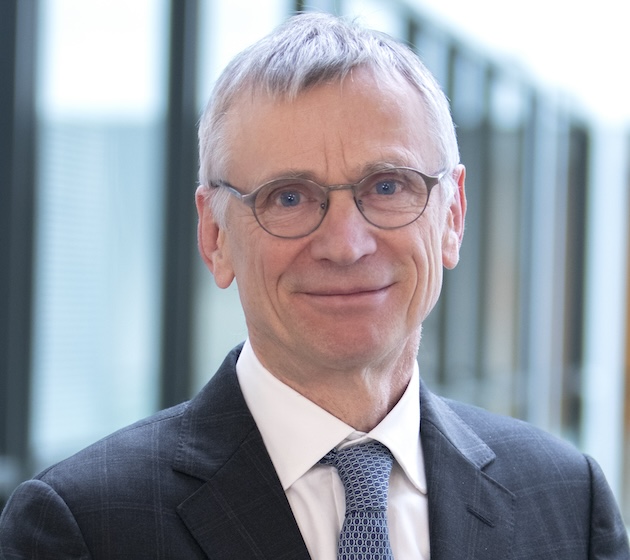
David Cooper, Acting Executive Secretary of the UN Convention on Biological Diversity (CBD).
Biodiversity Finance: On Track but at Slow Pace
The UN Biodiversity Convention aims to mobilize at least USD 20 billion per year by 2025 and at least USD 30 billion per year by 2030 for biodiversity-related funding from all sources, including the public and private sectors.
However, the current situation with biodiversity funding shows that while progress is happening, it’s not fast enough. Some countries and groups are trying hard to give more money to projects that help nature, but overall, it’s still below expectations, and there are unfilled promises, Cooper acknowledges.
“We need to see a serious road map,” Cooper says, “All countries, in particular the donor country community, have to see how we are going to achieve at least that USD 20 billion by 2025 because that’s imminent.”
He called on big donors to honor their commitments.
“It’s really important that the big donors who promise money actually follow through and give the money they said they would. We need everyone to work together to make sure there’s enough money to protect our plants, animals, and the places they live,” Cooper says. “Certainly, we need to see all countries put efforts behind all of the goals and targets of the framework and that, of course, includes those on financial resources.”
Cooper welcomed the decision by the Global Environment Facility (GEF) to establish a new fund, the Global Biodiversity Framework Fund. He said the CBD secretariat was working closely with Carlos Manuel Rodriguez, the GEF CEO, and his team.
“We then saw a number of contributions to that fund coming. The contribution from Canada is a significant one of 200 million Canadian dollars. Other significant donations came from Germany, Spain, Japan, and most recently, Luxembourg. Actually, the contribution from Luxembourg, if we look at its pro rata, given the size of the Luxembourg economy, is also quite generous, even though it’s only USD 7 million in total.”
National Biodiversity Strategies and Action Plans (NBSAPs)
It’s not only about funding, Cooper says, but countries showing their commitment to their agreements, including developing NBSAPs. He acknowledged that very few countries had submitted so far.
“It’s only a few countries so far, and Spain, Japan, China, France, Hungary, and Ireland have submitted their NBSAPS, as well as the European Union,” says Cooper.
While he is optimistic that all the countries will develop their targets, he recognizes that it’s a complex process.
“I think most countries are in the process of developing their national targets, which is the first thing they’re supposed to do. But this is a process that is also supposed to engage all the different sectors of the economy and all the different parts of society, with the engagement of local communities, indigenous peoples, businesses, and so on.”
The CBD supports the countries through the complexities.
“The developing countries in particular have been supported through the Global Environment Facility. We’ve also been organizing a number of regional dialogues so that countries can share their experience as they move forward,” Cooper says.
At COP15, it was decided that all countries should submit their NBSAPs, if possible, before COP16.
“If they’re not able to submit their full NBSAPS by then, then at least they should provide their updated national targets. So, we do expect many, many countries to have progressed on their NBSAPs by COP16. Immediately prior to COP16, there will be another meeting of the subsidiary body on implementation to also take stock of where we are on that.”
COP16: What’s In, What’s Out
The core focus of CBD COP16 is likely to revolve around the adoption and implementation of the Post-2020 Global Biodiversity Framework. This framework sets out the global targets and goals for biodiversity conservation and sustainable use for the next decade and beyond. Key aspects of the framework may include targets related to halting biodiversity loss, promoting sustainable resource management, enhancing ecosystem resilience, and ensuring equitable sharing of the benefits derived from biodiversity.
“I think I can highlight four key areas for COP 16,” says Cooper. “The first is that we have to see, and we have to have demonstrated progress in terms of implementation of the Global Biodiversity Framework. That means national targets are set. That means NBSAPs developed in at least a majority of countries. That means funds are flowing, which means, as I said before, a credible path towards this USD 20 billion by 2025 target. It also means the Global Biodiversity Framework Fund should be receiving more funds and supporting more projects.”
The second core issue will be the fair and equitable sharing of benefits from the use of Digital Sequence Information (DSI) on genetic resources. There was an agreement made at COP15 to establish this mechanism, but no details were fleshed out at that time, so those details are now being negotiated in an intergovernmental working group.
“Of course, the establishment of such a mechanism with a fund would give another major boost to the Convention because it would bring in another source of funding.”
The third area would be finance, he says.
“The fourth area that I would highlight is the need to further strengthen the role of indigenous peoples and local communities as key actors.”
He also points out that there’s a number of other issues, such as the issue of biodiversity and health and synthetic biology, that need to be managed, including looking at a risk assessment and risk management for, for instance, gene-edited mosquitoes.
“They’ve determined that the theme of the COP will be peace with nature, which is a broad theme that will include many, many issues,” he reveals.
Plastic Pollution Treaty and CBD’s Role
The fourth session of the Intergovernmental Negotiating Committee (INC-4) on plastic pollution in April 2024 at the Shaw Center in Ottawa, Canada, aims to develop an internationally legally binding instrument on plastic pollution, including in the marine environment, to end plastic pollution by 2040.
Ending plastic pollution is also one of the biodiversity targets, Cooper says, adding that the CBD is actively involved in the logistical organization of INC-4.
“Also, the reduction of waste from plastics and pollution from plastics is one of the elements of target 7 of the Kunming Montreal Global Biodiversity Framework. So, we are seeing the success of INC-4 negotiations as hugely important for the implementation of the Framework,” he says.
What to Watch out for Between Now and COP16
Although all eyes will be on the COP16 negotiations, there are a number of global events taking place in the next few months that will contribute to the agenda and determine the level of the world’s preparedness for the conference.
“The most important ones are obviously the SBSTTA (Subsidiary Body on Scientific, Technical, and Technological Advice) and the SBI (Subsidiary Body on Implementation), then this working group on Digital Sequence Information that will take place in August,” Cooper says.
Like the SBI, SBSTTA is a subsidiary body established under the CBD. While the SBI specifically assists in reviewing progress in the implementation of the Convention and identifies obstacles to its implementation, among other functions, SBSTTA plays a crucial role in ensuring that decisions made under the CBD are informed by the best available scientific evidence and technical expertise.
“Then we have the G7 and G20 processes coming up, which are important processes to show leadership. The CBD COP itself will be followed by the COPs of climate change and desertification, making the linkage between these. Also, we expect Colombia and the indigenous peoples will host just before COP, a pre-cop focusing on indigenous peoples and local communities and their roles,” Cooper says.
Finally, as a record 64 countries across the world hold their elections this year to elect a new national government, does this provide a unique opportunity to speak about biodiversity and should biodiversity, like climate change, be made an election issue?
“Definitely,” says Cooper.
“If we look at many of the extreme events that people suffered from, particularly last year, whether these be fires, wildfires, droughts, storms, or floods, you know, these are largely attributed by the media to climate change. Climate change is increasing the probability and severity of these events, but these events are also happening because of ecosystem degradation because we haven’t been managing biodiversity and ecosystems well. So, I think we all have an opportunity to make this message and these links clearer. Politicians have a particular responsibility to do so, and I hope more of them will do so as these various elections in various parts of the world pan out.”
IPS UN Bureau Report

